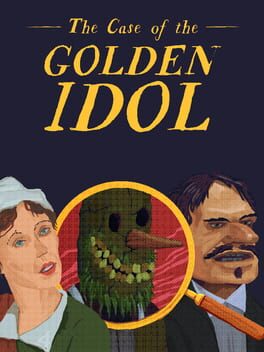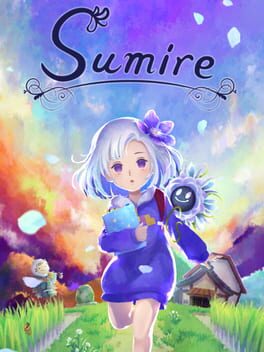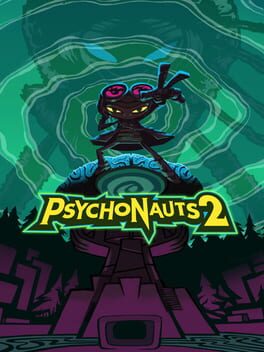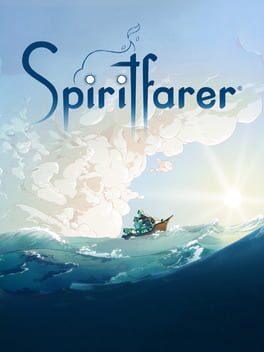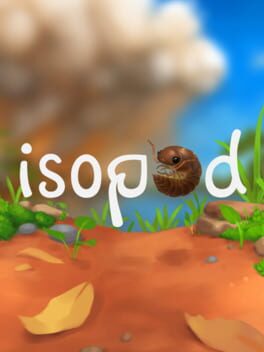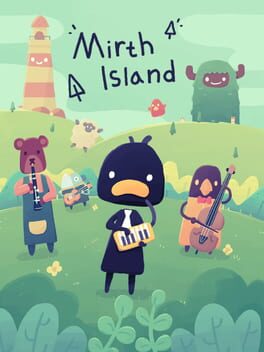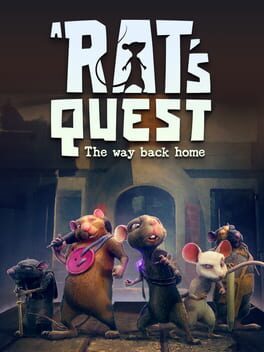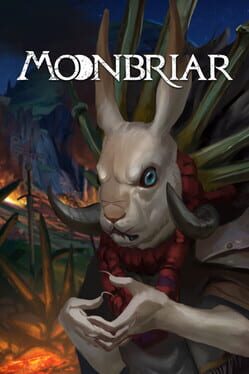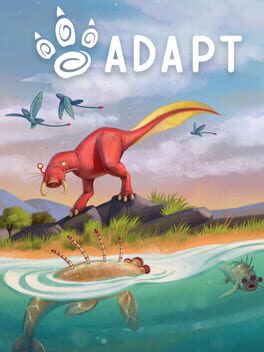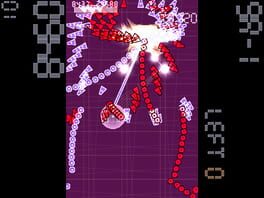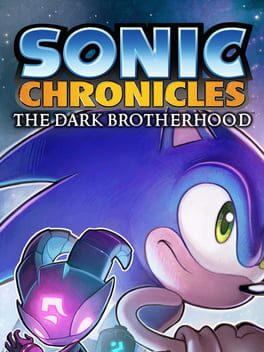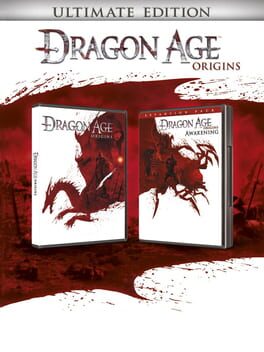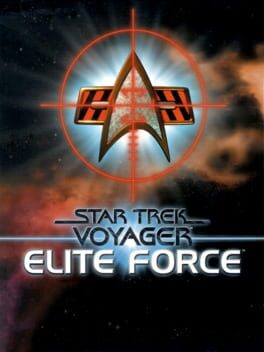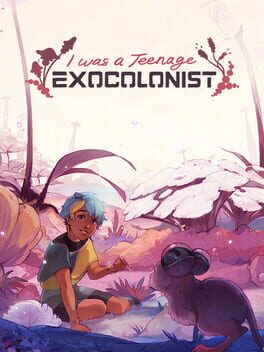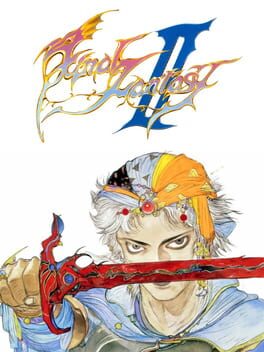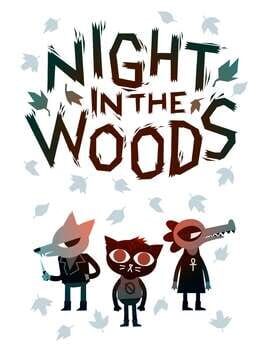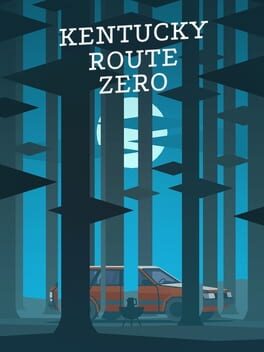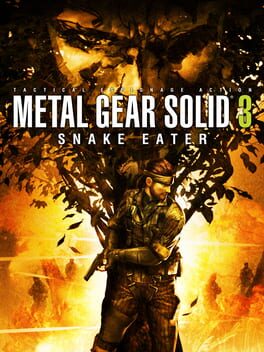rosawatts
BACKER
39 reviews liked by rosawatts
Balatro
2024
i hate (love) this game
Pep's Detective Deep Dive - Game 6
This was... something different. Rather than the usual "investigating a murder after the fact" murder mystery, Case Of The Golden Idol presents a static scene to you, and it's up to you to point-and-click your way to the truth of what exactly is going on in the story.
Clicking highlighted areas of interest presents you with a series of words, and you use these words to fill in the gaps of an incomplete "scroll", giving you the story. Seems simple at first, but as the game progresses it can get fiendishly difficult as the story spirals and some parts left me genuinely stumped. If you're really struggling there's a hint system available, but I never used it.
The only real thing stopping me from giving this a higher mark is that the story kind of fizzles out by the end, and I was left slightly let down by it. However, there's a 1970s-set sequel on the way so I'll be looking into that.
An interesting concept done very well, I definitely recommend this if you're looking for a different kind of mystery game.
This was... something different. Rather than the usual "investigating a murder after the fact" murder mystery, Case Of The Golden Idol presents a static scene to you, and it's up to you to point-and-click your way to the truth of what exactly is going on in the story.
Clicking highlighted areas of interest presents you with a series of words, and you use these words to fill in the gaps of an incomplete "scroll", giving you the story. Seems simple at first, but as the game progresses it can get fiendishly difficult as the story spirals and some parts left me genuinely stumped. If you're really struggling there's a hint system available, but I never used it.
The only real thing stopping me from giving this a higher mark is that the story kind of fizzles out by the end, and I was left slightly let down by it. However, there's a 1970s-set sequel on the way so I'll be looking into that.
An interesting concept done very well, I definitely recommend this if you're looking for a different kind of mystery game.
This review contains spoilers
i'm a big fan of metal gear, and i've played and enjoyed all the experiences i've had in the series so far. peace walker was kind of a small rock that found its way into my socks, since i had played the phantom pain before (a terrible mistake, yes), and the prejudice of it being a portable game also got to me, leaving the game as a low priority target until i felt like it
i have tried to play this game in the past via the ps3 port, and it was already kind of a disappointment then. i remember feeling that the game engine was ported 1:1 with some adaptations for a real controller to balance it out, but it just didn't work well. i've written on my review for the hd edition how i think it'd be a better experience if i played it on an actual portable console, so here we are
playing this on the vita made me glad that i didn't just have a psp, assigning the right stick to the camera was a godsend.
the game suffers from the same issues the hd port has (not something worth noting but hey), i was fighting against the controls more than i was fighting against the enemies of the game. bosses are a big pain in the ass, and good luck doing them non-lethally without previously knowing that 1. all bosses have a set number of regular troops before they run out and 2. you need to deal a certain amount of damage to the tank/helicopter/whatever and fulfill the previous requirement to make the captain pop-out and allow you to shoot him with the tranq gun. you know the rule of three (writing)? that helicopter fight in the main story needs the helicopter deploying reinforcements 4 times before you can aim for the helicopter itself (keep in mind it takes a considerable amount of time and effort to stun/sleep and fulton a single squad while a helicopter shoots rockets at you). because giving the player the illusion that a fight is nearly over is not quite there, you gotta break their expectations! make them think that there's no end!
mother base's progression forces replayability that just isn't there. you sure can repeat the same extracting side op dozens of times to fill up mother base, but if you'll have any sort of fun while doing so is another story
it's hard for me to judge the unlock/upgrade system if i have the phantom pain doing the same system but better lodged into my brain, i bet it was okay at the time? in a sense it makes peace walker a good game to bring with you on a deserted island, i guess
outer ops did not give me any signs that it was contributing to anything in my base besides killing/injuring my soldiers and boosting the morale of the rest
zeke made me discover another shoddy aspect of the game: collecting ai parts
it just didn't ring a bell to me anywhere that i was supposed to not hit the other parts of an ai weapon to get the main zeke parts, since those and the ai boards are kind of given the same hints, but that could just be me being bad at comprehending the game's script while i deal with the annoyance of having to fight a boss in this game
story-wise... *deep breaths*
the temptation to say that it felt "rushed" is strong, but i feel like maybe that isn't the case, i haven't looked into the story of the game's development but it's one case where it did successfully hook me until really close to the ending, where utter disappointment resided
the final non-boss mission (the one where you're fighting the helicopter and a bunch of dudes in nicaragua) felt to me as a naive attempt at what's supposed to be the game's "epic moment", with the right for heavens divide and everything, but it felt more forced than anything else, it certainly wasn't anything special at all, i just wanted it to end
surely the ending will make up for it right....?
that's already past the point where the whole main focus of the game is explained, but let me go back a little to say about the premise. having the boss made into an ai was okay? ish? back when i started i also wanted to know what the heck was going on
i'll ignore hot coldman's name to say that he was an okay villain, bit goofy but everything about him kind of looped back into being an okay depiction of a mad antagonist
strangelove was my favorite character in the entire peace walker cast, but i'm not really sure if she was worth making the story look like a poor fan continuation of 3. i was dumbfounded with the last cutscene thinking "god damn! this is really stupid!" and i didn't believe it ended like that, clutching up to callbacks and references like it was milking the previous game. i'd expand on this but it's just the general feel on how it was directed
but god, how i wish it ended like that. the true ending was the last straw: the only way i could possibly conceivably interpret it would be thinking it was kojima shitposting, and i'd be fine with that, there are some ridiculous jokes in the past entries and all, but they're all non-canon. big shoutout to the "date with paz" mission where it's implied snake has sex with a girl who was deemed underage until she's revealed to be a spy whos 10 years older than she originally was way after that mission. but anyway, making that shitpost of an ending canon is what really made me dislike this game. it's incredibly poor comparing to every other entry in the series (excl. portable ops, haven't played) and you're telling me metal gear solid five continues from this? i would've been better off with just the short summary that ground zeroes provides. at least there'd be no koi no yokushiryoku playing on the scene depicting the final boss, what a laugh that was, jeez
Edit: i felt this review had too much negativity, so i'll list out some things i liked about the game that i didn't mention
- the twist where amanda and her crew storm the base in nicaragua saving snake
- the overall message that the game tried to convey with the whole shiz about deterrence and peace walker sans the stuff related to the boss
- the 2001: a space odyssey references and mentions
- the cutscene artwork, ashley wood is a really good artist
- the references to che guevara, they were fun and it didn't seem unreasonable to jam those in - seeing snake bow before him is slightly humorous
...but those alone weren't worth my 30 hours invested. it's a game i'd watch a playthrough of instead of playing if i had the chance to turn back time and tell myself in the past that it wasn't gonna be worth it
i have tried to play this game in the past via the ps3 port, and it was already kind of a disappointment then. i remember feeling that the game engine was ported 1:1 with some adaptations for a real controller to balance it out, but it just didn't work well. i've written on my review for the hd edition how i think it'd be a better experience if i played it on an actual portable console, so here we are
playing this on the vita made me glad that i didn't just have a psp, assigning the right stick to the camera was a godsend.
the game suffers from the same issues the hd port has (not something worth noting but hey), i was fighting against the controls more than i was fighting against the enemies of the game. bosses are a big pain in the ass, and good luck doing them non-lethally without previously knowing that 1. all bosses have a set number of regular troops before they run out and 2. you need to deal a certain amount of damage to the tank/helicopter/whatever and fulfill the previous requirement to make the captain pop-out and allow you to shoot him with the tranq gun. you know the rule of three (writing)? that helicopter fight in the main story needs the helicopter deploying reinforcements 4 times before you can aim for the helicopter itself (keep in mind it takes a considerable amount of time and effort to stun/sleep and fulton a single squad while a helicopter shoots rockets at you). because giving the player the illusion that a fight is nearly over is not quite there, you gotta break their expectations! make them think that there's no end!
mother base's progression forces replayability that just isn't there. you sure can repeat the same extracting side op dozens of times to fill up mother base, but if you'll have any sort of fun while doing so is another story
it's hard for me to judge the unlock/upgrade system if i have the phantom pain doing the same system but better lodged into my brain, i bet it was okay at the time? in a sense it makes peace walker a good game to bring with you on a deserted island, i guess
outer ops did not give me any signs that it was contributing to anything in my base besides killing/injuring my soldiers and boosting the morale of the rest
zeke made me discover another shoddy aspect of the game: collecting ai parts
it just didn't ring a bell to me anywhere that i was supposed to not hit the other parts of an ai weapon to get the main zeke parts, since those and the ai boards are kind of given the same hints, but that could just be me being bad at comprehending the game's script while i deal with the annoyance of having to fight a boss in this game
story-wise... *deep breaths*
the temptation to say that it felt "rushed" is strong, but i feel like maybe that isn't the case, i haven't looked into the story of the game's development but it's one case where it did successfully hook me until really close to the ending, where utter disappointment resided
the final non-boss mission (the one where you're fighting the helicopter and a bunch of dudes in nicaragua) felt to me as a naive attempt at what's supposed to be the game's "epic moment", with the right for heavens divide and everything, but it felt more forced than anything else, it certainly wasn't anything special at all, i just wanted it to end
surely the ending will make up for it right....?
that's already past the point where the whole main focus of the game is explained, but let me go back a little to say about the premise. having the boss made into an ai was okay? ish? back when i started i also wanted to know what the heck was going on
i'll ignore hot coldman's name to say that he was an okay villain, bit goofy but everything about him kind of looped back into being an okay depiction of a mad antagonist
strangelove was my favorite character in the entire peace walker cast, but i'm not really sure if she was worth making the story look like a poor fan continuation of 3. i was dumbfounded with the last cutscene thinking "god damn! this is really stupid!" and i didn't believe it ended like that, clutching up to callbacks and references like it was milking the previous game. i'd expand on this but it's just the general feel on how it was directed
but god, how i wish it ended like that. the true ending was the last straw: the only way i could possibly conceivably interpret it would be thinking it was kojima shitposting, and i'd be fine with that, there are some ridiculous jokes in the past entries and all, but they're all non-canon. big shoutout to the "date with paz" mission where it's implied snake has sex with a girl who was deemed underage until she's revealed to be a spy whos 10 years older than she originally was way after that mission. but anyway, making that shitpost of an ending canon is what really made me dislike this game. it's incredibly poor comparing to every other entry in the series (excl. portable ops, haven't played) and you're telling me metal gear solid five continues from this? i would've been better off with just the short summary that ground zeroes provides. at least there'd be no koi no yokushiryoku playing on the scene depicting the final boss, what a laugh that was, jeez
Edit: i felt this review had too much negativity, so i'll list out some things i liked about the game that i didn't mention
- the twist where amanda and her crew storm the base in nicaragua saving snake
- the overall message that the game tried to convey with the whole shiz about deterrence and peace walker sans the stuff related to the boss
- the 2001: a space odyssey references and mentions
- the cutscene artwork, ashley wood is a really good artist
- the references to che guevara, they were fun and it didn't seem unreasonable to jam those in - seeing snake bow before him is slightly humorous
...but those alone weren't worth my 30 hours invested. it's a game i'd watch a playthrough of instead of playing if i had the chance to turn back time and tell myself in the past that it wasn't gonna be worth it
Final Fantasy XVI
2023
This review contains spoilers
When it was all over, and the final note from the final song rang out- I sat alone with an acceptance brought only thru engaging with a god honest masterpiece.
Final Fantasy XVI
2023
THE INDIFFERENT CRUELTY OF THE UNIVERSE WHEN THE INDOMITABLE HUMAN SPIRIT WALKS INTO THE ROOM:
i have a soft spot for a lot of the character designs but the actual game is extremely flawed and is destined to always stay that way now that its younger brother has proven to be mega successful. fly high king (lying through my teeth)
Sumire
2021
Its a really touching story about Sumire overcoming the loss of her Grandma and dealing with other interpersonal struggles like dealing with her parents splitting up or her friends disconnecting from her. Seeing her overcome all these simple but meaningful trials just felt so nice and wholesome to see. It's a really nice short tale almost anyone can relate to.
Blackgate was not even close to what I had in mind for my first new completion of 2023, but I needed space for Ridge Racer Type 4 and Secret Agent Clank so sacrifices had to be made.
In all honestly, this wasn't nearly as bad as expected. It was even almost pretty good. I am not really a fan of this genre from all the games I've tried but I think the fact that its Batman and the atmosphere were more than enough to get me moving forward. I think the Arkham formula honestly transfers quite well to this format, but there are a few pretty big hiccups that stop it from reaching its full potential.
Namely the controls are pretty finicky. Especially on vita, the bumpers are just really not reliable and they don't do this game any favors. It just feels a little bit too clunky. As im sure is common with this genre the amount of backtracking is just way too much. I really don't see why there is no way to fast travel between sections. Im sure most of my playtime was spent running around like a headless chicken trying to figure out how to just leave an area to go where I needed to be, and the map doesnt help with that at all. It's a 2D map but there's multiple sections where you can interact with the background or go up floors and this just does not translate which makes navigating more frustrating than it needs to be. Not to mention it doesn't orient itself either so you have to constantly open and close it to make sure you're going the right direction. Another complaint with this is the boss fights. While i think the Arkham combat works well on handheld still, most of the boss fights are more puzzle oriented. But they're just really annoying lmao. I don't think I had fun with a single one of them. Thankfully you can find the Darkest Night suit which negates any damage done to you which made the final boss fight much less of a headache. The last complaint is the story is just kinda sucky lol. You can fight the bosses in any order but that doesnt really change much. The biggest pro is Catwoman is featured heavily in it and she's my favorite DC character. But the ending is just really abrupt and unsatisfying. Its not terrible, it is a handheld spinoff after all. But its just another thing on the pile that kept me from loving it.
All those negatives aside, I still enjoyed my time with Blackgate overall and I liked it a lot more than I liked the actual Arkham Origins. It's a weird, often confusing and sometimes annoying mess but it was worth a play. In the end, at the very least I can cross beating a metroidvania off the bucket list.
Thank's for reading y'all, this has been a Nancyfly mini review <3
Nancymeter - 69/100
Time Played - 16 hours 46 minutes
Trophy Completion - 53% (21/31)
Game Completion #2 of January
Game Completion #2 of 2023
In all honestly, this wasn't nearly as bad as expected. It was even almost pretty good. I am not really a fan of this genre from all the games I've tried but I think the fact that its Batman and the atmosphere were more than enough to get me moving forward. I think the Arkham formula honestly transfers quite well to this format, but there are a few pretty big hiccups that stop it from reaching its full potential.
Namely the controls are pretty finicky. Especially on vita, the bumpers are just really not reliable and they don't do this game any favors. It just feels a little bit too clunky. As im sure is common with this genre the amount of backtracking is just way too much. I really don't see why there is no way to fast travel between sections. Im sure most of my playtime was spent running around like a headless chicken trying to figure out how to just leave an area to go where I needed to be, and the map doesnt help with that at all. It's a 2D map but there's multiple sections where you can interact with the background or go up floors and this just does not translate which makes navigating more frustrating than it needs to be. Not to mention it doesn't orient itself either so you have to constantly open and close it to make sure you're going the right direction. Another complaint with this is the boss fights. While i think the Arkham combat works well on handheld still, most of the boss fights are more puzzle oriented. But they're just really annoying lmao. I don't think I had fun with a single one of them. Thankfully you can find the Darkest Night suit which negates any damage done to you which made the final boss fight much less of a headache. The last complaint is the story is just kinda sucky lol. You can fight the bosses in any order but that doesnt really change much. The biggest pro is Catwoman is featured heavily in it and she's my favorite DC character. But the ending is just really abrupt and unsatisfying. Its not terrible, it is a handheld spinoff after all. But its just another thing on the pile that kept me from loving it.
All those negatives aside, I still enjoyed my time with Blackgate overall and I liked it a lot more than I liked the actual Arkham Origins. It's a weird, often confusing and sometimes annoying mess but it was worth a play. In the end, at the very least I can cross beating a metroidvania off the bucket list.
Thank's for reading y'all, this has been a Nancyfly mini review <3
Nancymeter - 69/100
Time Played - 16 hours 46 minutes
Trophy Completion - 53% (21/31)
Game Completion #2 of January
Game Completion #2 of 2023
Psychonauts 2
2021
This game is exactly what a sequel should be - better in every way. This is one of those games I wish I'd played when it first released, because it truly is something special. Very interested in where Double Fine will go after this
Spiritfarer
2020
I’m sorry, Spiritfarer. I never really gave you enough of a fighting chance, and you came back right when I needed you again. Consider this review my apology.
After playing through That Dragon, Cancer this summer, I realized that I wasn’t being fair to this genre of “games for impact.” We don’t all play games for the same reason. Sure, plenty of games market themselves as straight entertainment, played for pleasure and excitement. But there are games that aim to not necessarily be fun, but rather be compelling. Games that seek to provoke a wide range of emotions and questions rather than just provide means to an end.
Spiritfarer was one such title that I admit I originally approached with the wrong mindset. It did not do me any favors to rush through in order to complete the game on my limited PC Game Pass, or to try and move onto the next title on my growing backlog, because this is a game both about taking your time while making the most of every moment possible. I also found myself stymied by the supposedly “shallow” gameplay loop while also complaining about its excessive runtime. That’s why upon my second playthrough of Spiritfarer, finally buying my own copy on Steam, I found myself constantly surprised and overwhelmed that all of these preconceptions turned out to be wrong. It all starts by properly contextualizing Spiritfarer’s appeal and purpose.
Just like That Dragon, Cancer, Spiritfarer grapples with the omnipresence of death differently. Death may be a game mechanic, but it is not a punishment; rather, it is the final destination. Heavily inspired by Spirited Away’s hotel for spirits, Spiritfarer tackles one important question; what if we didn’t fear death as much? As part of the Death Positivity movement, the game encourages its players to think of death as more than just a mechanism or taboo subject, and to have healthy and open conversations as to speak more freely regarding all the consequences and feelings surrounding it. To better handle its subject matter, Thunder Lotus focuses the gameplay loop on preparing you to care for souls at the end of their lives as well as the various processes associated with the cycle of grief.
As the newly dubbed Spiritfarer, the player character as Stella must find lone spirits scattered across the vast seas, and handle their final requests. These requests can range from a variety of fetch quests, to constructing little homes and decorations for them, to feeding them their favorite meals and handling their last regrets and affairs with other characters. As a backbone for this request structure, Stella must construct other various facilities and travel to other locales to gather resources and both upgrade the ship and gain new abilities to access new events. Once these last requests have been fulfilled, the spirit will ask to be taken away to the Everdoor, and pass on to the afterlife.
One particular complaint kept popping up in the back of my mind as I fulfilled my duties. A year ago, a close friend and I had a discussion regarding Spiritfarer, when he complained that Spiritfarer didn’t feel cozy at all. If anything, he felt pressured and constantly anxious that there was always something more to do. There were new crops to tend to, or more ore to smelt, or more fish to find and more dishes to cook, and so on so forth. I certainly related to his dilemma; in fact, during quiescent nights where I had the option to go to sleep to start a new day, I often found myself cleaning up my remaining tasks and frantically checking my stockpiles to see if anything else had to be worked on. I simply could not afford to lose time; if daytime was the only acceptable time to travel in order to explore new islands, then even my nighttime had to be optimized to fulfill my obligations and stay “on schedule.”
It was then that I realized, that there was a method to Spiritfarer’s madness. This constant state of scrambling and juggling tasks to keep everyone happy that had made me feel so uncomfortable… was the same exact state experienced by those in palliative care. Moreover, those were the same feelings that my family went through when taking care of my grandmother and grandfather on my mother’s side during their last years. They were often fickle with exactly what had to be done; sometimes, I didn’t know if they even knew what they really wanted. We often left my grandma’s apartment with this sense of restlessness that kept us up at night, unsure if there was even anything left we could do to ease their final moments. It was this delicate but never-ending push and pull that we had become so accustomed to, that I had almost forgotten the sensation after my grandma left us in March 2020. I can sincerely say that no other video game I have ever played has forced me to reconfront my feelings and memories from back then… and I can’t help but respect Thunder Lotus for the audacity to not only address it, but also impart those feelings so effectively through gameplay as an compelling example of player perspective.
To Spiritfarer’s credit, I later came to understand that this sense of coziness is not lost at all, because there are plenty of surrounding elements that alleviate this heaviness. The art style, as well as the color palette, are key factors; the graphics are heavily influenced by the Japanese woodblock painter Hiroshi Yoshida, which the lead artist stated as “bringing [her] serenity.” That tranquility and desire to explore the landscape was a key motivation behind the lush and vibrant environments of Spiritfarer, combined with the use of soft pastels and a lack of the color “black;” darkness is instead communicated through softer alternatives such as dark reds, blues, and greys. It’s not without its use of contrast either (see: Bruce and Mickey’s “McMansion” of clashing red and white), which both allows the game to express more clearly express character personalities while providing the opportunity to allow for the player to experience “negative feelings” such as sadness in a softer environment. Finally, Spiritfarer’s fluid hand-drawn animation also breathes life into its many characters while promoting mobility through Spiritfarer’s expressive gameplay.
Spiritfarer also shows further care in establishing mood and ambience as to gently tuck players into an emotional experience outside of the art style. Firstly, Max LL’s accompanying soundtrack appropriately imparts moods without the need for excessive flair and gusto. Simple piano, string, and flute melodies provide ambient backdrops in tunes such as At Sea or At Night. More exotic instruments play important parts in tracks such as Furogawa to convey curiosity, or more upbeat pieces such as Hummingberg excite players into romping around the island to soak in the sights. Then, you’ve got your frenetic tunes such as Freeing the Dragon and Pulsar Pursuit to spur the player into action and snag as many timed collectibles as possible to assuage the spirits’ wants and fears. Finally, epics such as Last Voyage convey emotional upwellings through volume swells while establishing a sensation of finality to bring journeys to a close. Honestly, I couldn’t have asked for a more fitting soundtrack to instill a sense of adventure for Spiritfarer while appropriately illustrating more thoughtful moods along the way.
Secondly, while many post-death games are often filled with hostile and frightening creatures, Spiritfarer instead chooses to surround the player with friendly and welcoming personalities. Of course, there’s the spirits themselves; while some spirits can initially come off as aloof or even acerbic and uncompromising at times, you soon get to learn more about their backstories and interests that allow you to warm up and celebrate with them. Around the vast expanses of Spiritfarer are also many sea creatures and island inhabitants that are sincerely interested in you, with many going out of their way to help you in your role of caring for your friends. There’s also a lot of silly “dumb” jokes and melancholy humor across many of these characters to poke light fun at the world they live in and the situations that Stella finds herself in, all while providing a welcome distraction when juxtaposed with the emotional subject matter of the game itself.
Further adding to this coziness is the lack of a permanent “fail-state” within Spiritfarer. There’s no way to reach a “game-over” screen or enter a state where the player is directly punished for errors. For example, mining requires a specific timing of holding down and releasing the X button, but holding for too long doesn’t lead to negative consequences such as losing resources or health. Rather, you receive a cutely animated sequence where Stella accidentally drops her pickaxe and glances back at what happens, before she picks up the pickaxe again with a smile on her face. It’s like the game is gently encouraging you to try again; sure, you didn’t play optimally and messed up your timing, but it’s okay, for you can always give it another go. Vice versa, you’re also rewarded for playing well due to the ability to save time from optional animations and the potential to gain additional resources (i.e. cutting planks strictly by the lines gets you double the amount of planks you would have gained otherwise), but failure in these cases is not so much a permanent setback, but rather a delayed success.
Similarly, this “feeling” of failure translates to the spirits themselves. If the spirits aren’t fed properly, they will complain to Stella and have lowered mood. Again, this isn’t a permanent setback, because this mood can be risen by feeding them their favorite dishes and hugging them. Of course, there are visible consequences here to playing “well;” happy and ecstatic characters will often aid Stella by playing music to make other characters happier as well, or participate in the ship’s tasks by giving you valuable resources (raw ingredients, ingots, dishes, luxury sellables, etc). Most importantly though, these characters feel alive, both because of their written design/stories (often heavily based off the development team’s friends and families, resulting in a lot of personal investment) and because the gameplay loop of performing their last rites and caring for them creates attachment; you get to learn their histories a bit better based off the stories they tell you as they request specific chores that reflect upon their quirks and personalities.
As a result, I found Spiritfarer’s gameplay loop engaging due to its great emotional investment; not only does it give you just enough time to grow attached to spirits before sending them off, it also emulates aspects of grieving extremely well in a video game setting. For example, as characters finally depart for the Everdoor, all other characters on the ship will gather around the departing rowboat to say their farewells, similar to how friends and family surround loved ones on their deathbeds. Another example of this occurs during scripted resource gathering events scattered across the map; you would typically need to speak to a specific spirit to begin the event, but once that character has departed, Stella must instead start the event from the departed spirit’s door. This connection, as well as the inability to remove the deceased spirit’s former house (now analogous to that of a tombstone), constantly reminds the player of the experiences and memories of those who have moved on, and emulates the process of revisiting final resting places or old ramblings of deceased loved ones. Thus, Spiritfarer thoughtfully embeds traces of former spirits to instill both metaphorical meaning and surface meaning that their lives will forever remain with you. By constantly exposing the player to so many different spirits and their transitory stays, Thunder Lotus is able to properly guide players to express these healthy mechanisms that come with loss.
As a related aside, Spiritfarer, similarly to That Dragon, Cancer, utilizes the medium’s ability to capture specific instances to allow players to properly adjust for events in-game. We’ve already talked about the game’s leniency with regards to its fail-states, since every “negative” externality can be quickly superseded with the proper actions; as a result, there are no lasting consequences to playing at your own pace and no real “wrong” choices to be made. However, Spiritfarer also creates opportunities to let the player soak in emotionally-heavy moments without the passage of time interfering, such as the Everdoor scenes. Here, the player can reflect in this frozen moment in ludic space and take all the time they need to absorb the reality of the situation. But as with That Dragon, Cancer, the player must eventually progress and move on, just like real life.
My prior emphasis upon this emotional attachment to characters through the busying gameplay loop might imply that the game itself is mechanically lacking… but I honestly don’t believe that's true. Spiritfarer controls extremely well, especially for a game where the emphasis isn’t necessarily precision platforming. By the end of the game, you’ve got expanded abilities to double jump, mid-air dash, float, and cling to ziplines to quickly zoom up and down and build up momentum. These movement options are further aided by the everchanging landscape of the ship itself, which naturally evolves over time, both from a want to create more aesthetically pleasing or simple to navigate structures, and from a need to construct additional facilities for resource gathering/housing spirits. Furthermore, this structure serves an important purpose, not just as a playground where Stella can bounce and run around, but also as the main stage where resource gather events at sea take place, and Stella must quickly move around the ship to snatch as many collectibles as possible before time runs out. Finally, traversing the expanding ship can be aided by constructing optional devices such as bouncy umbrellas or air-draft machines, should raw jumping on top of houses not suffice enough for clean movement. As such, these movement mechanics and design opportunities provide welcome outlets for creative expression and player agency, which contrasts nicely with the lack of control that often comes attached to games about death.
Finally, there’s a real sense of progression to be found in Spiritfarer, when compared to other “artistic” and emotional indie titles such as Sea of Solitude. As mentioned prior, the ability to unlock new movement options by visiting shrines help keep the player advancing to the next stage, whether it be a signified by an out-of-reach chest or a traversable element such as an air current that you don’t have the movement tech to exploit. Moreover, these upgrades require obols (which are usually given to the player when new spirits come aboard), just as the ship upgrades that allow you to travel to new areas require Spirit Flowers that are left behind from a spirit’s passing. As a result, the personal investment from meeting and saying good-bye to spirits is matched by the extrinsic investment gained from interacting with the spirits, resulting in a powerful marrying of storytelling and gameplay mechanics. By progressing the story, the player is in turn rewarded with new areas, abilities, and accessories to create further opportunities of discovery and novelty.
That said, there are a few other nitpicks regarding certain aspects of Spiritfarer’s design, such as moments of less focused dialogue writing. Spirits will often run out of things to say, and that might limit interaction on the ships outside of jobs to scant bumps where they tell you they’re hungry, especially when you’re super busy micromanaging other tasks. This honestly doesn’t bother me as much as before (since we as humans will inevitably run out of interesting things to say); however, it is a bit more annoying speaking with non-spirit NPCs and either getting “trapped” in several lines where I had to mash X to move on, or being confronted with terse and meaningless scripts where the NPC would continually parrot some variation of “Hello. Leave me alone now.” This wouldn’t be as problematic if I didn’t feel the need to speak with every generic NPC to try and fulfill the requirement, since the “correct” NPC is not marked.
While I did find the gameplay loop much more palatable upon my second playthrough, I do agree that it’s easy to feel as if there’s a bit of padding near the end of the game as well. By this time, most of the spirits have departed your ship, and it’ll probably be down to Stella and a few remaining hardy spirits to pick up the pieces. It can definitely feel a bit lonely and out of place having to finish the remainder of Stella’s backstory with little spirit interaction in the last few hours. To its credit, Spiritfarer remedies this somewhat by finally allowing you to travel at night to quickly sweep up the story if you so desire, and with most bus stations unlocked and most speed upgrades having been fulfilled at this point, it’s not too arduous of a task. I do wish that there was a way to speed up time in Spiritfarer’s endgame though, since the backstory can only really be accomplished at night. As mentioned prior, you can fall asleep to skip nighttime and proceed with daytime events, so it is a little ironic that Spiritfarer’s endgame suffers from the exact opposite problem of running out of things to do in the day and lacking an analogous mechanism to get right back to the story at night.
I’m willing to look past these minor issues and more though, because ultimately those shortcomings end up making the game feel more human somehow. I tend to be a completionist at heart, wanting to 100% every experience and see everything there is to see. But I had to throw away that mentality and go against all my previous instincts, because Spiritfarer is a game about brevity.
While in the video game space, the developers have provided enough opportunities to artificially extent deadlines when so desired, it is Spiritfarer’s impermanence that makes its experiences so fruitful. I didn’t have enough time to learn every single detail about all the spirits, nor am I sure that the spirits were necessarily prepared to spill their entire life story in a single sitting to someone whom they had just met. Similarly, this experience’s meaning would be greatly diminished if you just let it stretch on to infinity and beyond. You most likely won’t have the time to finish every single task or close every loop… and that’s okay too.
Ultimately, while it can feel off-putting to some that characters can seem inscrutable to some degree (which may urge players to seek additional details on a wiki or in the Spiritfarer Artbook), I found myself content with what I knew. The condensed experiences that I had with these characters more than moved me upon my journey, and in fact put me in a headspace where I constantly found myself translating these experiences to my real life. Atul made me wonder if I really got to know my deceased relatives and friends well enough. Gustav left me contemplative regarding humanity’s eternal struggle with meaning. Stanley left my heart broken that innocence, while powerful, was just as fleeting as life itself. And Alice’s story left me speechless and frightened, because I saw signs of my grandmother within her.
That was, until Christmas night, when my dad received the call that my grandma on my father’s side had suffered a stroke. How bitterly ironic that the exact moment as I finished my second playthrough, my grandmother was left in a coma and I’d be forced to recontextualize my experiences once again. I knew that playing Spiritfarer would prepare me for this… but I wasn’t prepared for it to be this soon.
Had these lessons imparted upon me not meant anything? Sure, Spiritfarer is a game about dying… but it is also a game about living with death. Honor those who have moved on, so that you make the most of every moment with those who are still here. I hadn’t gotten the chance to see my grandma since a family vacation right before the 2020 outbreak, and I was hoping that someday, I’d get the chance to make it up to her. Now, I might not even get that chance. What could I even do at this point? Was my best not good enough anymore? Was my time spent all for naught?
I don’t really know. I spent a couple of days agonizing over my inability, my words feeling empty and my actions feeling directionless. I’m still waiting, because at this point, that’s all I have left.
But I’d like to think that my time wasn’t wasted. I don’t wish to make the same mistakes again… even if it might be too late this time. I think a game that’s willing to be as boldly emotionally vulnerable as Spiritfarer, despite all its potential pacing and mechanical issues, is something that has to be shared and treasured regardless of consequences. We can’t let trivial issues stop us from discussing that which is feared to be discussed, because we don’t have all the time in the world to pretend that everything’s okay. We wouldn’t improve if we never erred, and even if some missteps can’t be taken back… at least we can try to stop others from following our paths by connecting and sharing stories, right?
I can’t deny that Spiritfarer might not have hit me as hard the second time had these unfortunate events not occurred almost immediately after finishing. But I also can’t deny that Spiritfarer’s narrative power is the reason why I will always associate this game with everything that’s happened, nor can I think of any game that would have better prepared me for this moment and left such an impact upon me than Spiritfarer. Regardless of any gripes I may have had, this game is now a part of me, and I’m honestly not sure if I would change anything that I had experienced, lest I somehow forget about everything I strove to become moving forward.
So, let me leave you with these final thoughts of what I learned from Spiritfarer.
Grief is not a wave; it is an ocean. Every time you glance at it from a distance, you think you’ll be ready, but then it hits you, and you’re still swept away. As it washes over you, you start to wonder what it’s like to drown. Just to linger in that space a little longer, to try and lose yourself again in that gap in time where there was, before there wasn’t.
But there is nothing deep about drowning. Ultimately, we must carry on, for just as life has no meaning without death, those who pass on have no meaning without those who remain. Your ship will keep getting rocked by tide after tide, storm after storm, and you still might not be ready by the 2nd, 3rd, 4th, or however many waves hit you over and over. Nevertheless, you learn to navigate the waters a little better each time. There’s nothing wrong with getting seasick, but that doesn’t mean you have to drown.
Love is watching someone die. But love is so much more than that too. Love is a balancing act between letting others in and watching them leave. Love is living every day like it’s your last, but realizing it’s okay to forget about life too. Love is learning to accept everything about us: the pleasures, the turmoil, the fallacies, all of it. Love is preparing for the inevitable while savoring the ephemeral.
Love… is letting go.
Sources referenced:
Representation of Death in Independent Videogames: Providing a Space for Meaningful Death Reflection
Spiritfarer And Death Positivity
Corporate Intervention In Video Games
(also please see Fudj's separate review of Spiritfarer on this site, as I find that it effectively communicates many of its strengths and provided motivation to write this up)
Spiritfarer Explained: Letting Go Is Everything
Mindful Games: Spiritfarer
Spiritfarer Documentary: A Game About Dying
Healing Together on Discord: The Spiritfarer Community
Zero Punctuation: Spiritfarer
Spiritfarer's Art Book: Can be found here or purchased as part of Farewell Editions or separately on GOG/Steam.
After playing through That Dragon, Cancer this summer, I realized that I wasn’t being fair to this genre of “games for impact.” We don’t all play games for the same reason. Sure, plenty of games market themselves as straight entertainment, played for pleasure and excitement. But there are games that aim to not necessarily be fun, but rather be compelling. Games that seek to provoke a wide range of emotions and questions rather than just provide means to an end.
Spiritfarer was one such title that I admit I originally approached with the wrong mindset. It did not do me any favors to rush through in order to complete the game on my limited PC Game Pass, or to try and move onto the next title on my growing backlog, because this is a game both about taking your time while making the most of every moment possible. I also found myself stymied by the supposedly “shallow” gameplay loop while also complaining about its excessive runtime. That’s why upon my second playthrough of Spiritfarer, finally buying my own copy on Steam, I found myself constantly surprised and overwhelmed that all of these preconceptions turned out to be wrong. It all starts by properly contextualizing Spiritfarer’s appeal and purpose.
Just like That Dragon, Cancer, Spiritfarer grapples with the omnipresence of death differently. Death may be a game mechanic, but it is not a punishment; rather, it is the final destination. Heavily inspired by Spirited Away’s hotel for spirits, Spiritfarer tackles one important question; what if we didn’t fear death as much? As part of the Death Positivity movement, the game encourages its players to think of death as more than just a mechanism or taboo subject, and to have healthy and open conversations as to speak more freely regarding all the consequences and feelings surrounding it. To better handle its subject matter, Thunder Lotus focuses the gameplay loop on preparing you to care for souls at the end of their lives as well as the various processes associated with the cycle of grief.
As the newly dubbed Spiritfarer, the player character as Stella must find lone spirits scattered across the vast seas, and handle their final requests. These requests can range from a variety of fetch quests, to constructing little homes and decorations for them, to feeding them their favorite meals and handling their last regrets and affairs with other characters. As a backbone for this request structure, Stella must construct other various facilities and travel to other locales to gather resources and both upgrade the ship and gain new abilities to access new events. Once these last requests have been fulfilled, the spirit will ask to be taken away to the Everdoor, and pass on to the afterlife.
One particular complaint kept popping up in the back of my mind as I fulfilled my duties. A year ago, a close friend and I had a discussion regarding Spiritfarer, when he complained that Spiritfarer didn’t feel cozy at all. If anything, he felt pressured and constantly anxious that there was always something more to do. There were new crops to tend to, or more ore to smelt, or more fish to find and more dishes to cook, and so on so forth. I certainly related to his dilemma; in fact, during quiescent nights where I had the option to go to sleep to start a new day, I often found myself cleaning up my remaining tasks and frantically checking my stockpiles to see if anything else had to be worked on. I simply could not afford to lose time; if daytime was the only acceptable time to travel in order to explore new islands, then even my nighttime had to be optimized to fulfill my obligations and stay “on schedule.”
It was then that I realized, that there was a method to Spiritfarer’s madness. This constant state of scrambling and juggling tasks to keep everyone happy that had made me feel so uncomfortable… was the same exact state experienced by those in palliative care. Moreover, those were the same feelings that my family went through when taking care of my grandmother and grandfather on my mother’s side during their last years. They were often fickle with exactly what had to be done; sometimes, I didn’t know if they even knew what they really wanted. We often left my grandma’s apartment with this sense of restlessness that kept us up at night, unsure if there was even anything left we could do to ease their final moments. It was this delicate but never-ending push and pull that we had become so accustomed to, that I had almost forgotten the sensation after my grandma left us in March 2020. I can sincerely say that no other video game I have ever played has forced me to reconfront my feelings and memories from back then… and I can’t help but respect Thunder Lotus for the audacity to not only address it, but also impart those feelings so effectively through gameplay as an compelling example of player perspective.
To Spiritfarer’s credit, I later came to understand that this sense of coziness is not lost at all, because there are plenty of surrounding elements that alleviate this heaviness. The art style, as well as the color palette, are key factors; the graphics are heavily influenced by the Japanese woodblock painter Hiroshi Yoshida, which the lead artist stated as “bringing [her] serenity.” That tranquility and desire to explore the landscape was a key motivation behind the lush and vibrant environments of Spiritfarer, combined with the use of soft pastels and a lack of the color “black;” darkness is instead communicated through softer alternatives such as dark reds, blues, and greys. It’s not without its use of contrast either (see: Bruce and Mickey’s “McMansion” of clashing red and white), which both allows the game to express more clearly express character personalities while providing the opportunity to allow for the player to experience “negative feelings” such as sadness in a softer environment. Finally, Spiritfarer’s fluid hand-drawn animation also breathes life into its many characters while promoting mobility through Spiritfarer’s expressive gameplay.
Spiritfarer also shows further care in establishing mood and ambience as to gently tuck players into an emotional experience outside of the art style. Firstly, Max LL’s accompanying soundtrack appropriately imparts moods without the need for excessive flair and gusto. Simple piano, string, and flute melodies provide ambient backdrops in tunes such as At Sea or At Night. More exotic instruments play important parts in tracks such as Furogawa to convey curiosity, or more upbeat pieces such as Hummingberg excite players into romping around the island to soak in the sights. Then, you’ve got your frenetic tunes such as Freeing the Dragon and Pulsar Pursuit to spur the player into action and snag as many timed collectibles as possible to assuage the spirits’ wants and fears. Finally, epics such as Last Voyage convey emotional upwellings through volume swells while establishing a sensation of finality to bring journeys to a close. Honestly, I couldn’t have asked for a more fitting soundtrack to instill a sense of adventure for Spiritfarer while appropriately illustrating more thoughtful moods along the way.
Secondly, while many post-death games are often filled with hostile and frightening creatures, Spiritfarer instead chooses to surround the player with friendly and welcoming personalities. Of course, there’s the spirits themselves; while some spirits can initially come off as aloof or even acerbic and uncompromising at times, you soon get to learn more about their backstories and interests that allow you to warm up and celebrate with them. Around the vast expanses of Spiritfarer are also many sea creatures and island inhabitants that are sincerely interested in you, with many going out of their way to help you in your role of caring for your friends. There’s also a lot of silly “dumb” jokes and melancholy humor across many of these characters to poke light fun at the world they live in and the situations that Stella finds herself in, all while providing a welcome distraction when juxtaposed with the emotional subject matter of the game itself.
Further adding to this coziness is the lack of a permanent “fail-state” within Spiritfarer. There’s no way to reach a “game-over” screen or enter a state where the player is directly punished for errors. For example, mining requires a specific timing of holding down and releasing the X button, but holding for too long doesn’t lead to negative consequences such as losing resources or health. Rather, you receive a cutely animated sequence where Stella accidentally drops her pickaxe and glances back at what happens, before she picks up the pickaxe again with a smile on her face. It’s like the game is gently encouraging you to try again; sure, you didn’t play optimally and messed up your timing, but it’s okay, for you can always give it another go. Vice versa, you’re also rewarded for playing well due to the ability to save time from optional animations and the potential to gain additional resources (i.e. cutting planks strictly by the lines gets you double the amount of planks you would have gained otherwise), but failure in these cases is not so much a permanent setback, but rather a delayed success.
Similarly, this “feeling” of failure translates to the spirits themselves. If the spirits aren’t fed properly, they will complain to Stella and have lowered mood. Again, this isn’t a permanent setback, because this mood can be risen by feeding them their favorite dishes and hugging them. Of course, there are visible consequences here to playing “well;” happy and ecstatic characters will often aid Stella by playing music to make other characters happier as well, or participate in the ship’s tasks by giving you valuable resources (raw ingredients, ingots, dishes, luxury sellables, etc). Most importantly though, these characters feel alive, both because of their written design/stories (often heavily based off the development team’s friends and families, resulting in a lot of personal investment) and because the gameplay loop of performing their last rites and caring for them creates attachment; you get to learn their histories a bit better based off the stories they tell you as they request specific chores that reflect upon their quirks and personalities.
As a result, I found Spiritfarer’s gameplay loop engaging due to its great emotional investment; not only does it give you just enough time to grow attached to spirits before sending them off, it also emulates aspects of grieving extremely well in a video game setting. For example, as characters finally depart for the Everdoor, all other characters on the ship will gather around the departing rowboat to say their farewells, similar to how friends and family surround loved ones on their deathbeds. Another example of this occurs during scripted resource gathering events scattered across the map; you would typically need to speak to a specific spirit to begin the event, but once that character has departed, Stella must instead start the event from the departed spirit’s door. This connection, as well as the inability to remove the deceased spirit’s former house (now analogous to that of a tombstone), constantly reminds the player of the experiences and memories of those who have moved on, and emulates the process of revisiting final resting places or old ramblings of deceased loved ones. Thus, Spiritfarer thoughtfully embeds traces of former spirits to instill both metaphorical meaning and surface meaning that their lives will forever remain with you. By constantly exposing the player to so many different spirits and their transitory stays, Thunder Lotus is able to properly guide players to express these healthy mechanisms that come with loss.
As a related aside, Spiritfarer, similarly to That Dragon, Cancer, utilizes the medium’s ability to capture specific instances to allow players to properly adjust for events in-game. We’ve already talked about the game’s leniency with regards to its fail-states, since every “negative” externality can be quickly superseded with the proper actions; as a result, there are no lasting consequences to playing at your own pace and no real “wrong” choices to be made. However, Spiritfarer also creates opportunities to let the player soak in emotionally-heavy moments without the passage of time interfering, such as the Everdoor scenes. Here, the player can reflect in this frozen moment in ludic space and take all the time they need to absorb the reality of the situation. But as with That Dragon, Cancer, the player must eventually progress and move on, just like real life.
My prior emphasis upon this emotional attachment to characters through the busying gameplay loop might imply that the game itself is mechanically lacking… but I honestly don’t believe that's true. Spiritfarer controls extremely well, especially for a game where the emphasis isn’t necessarily precision platforming. By the end of the game, you’ve got expanded abilities to double jump, mid-air dash, float, and cling to ziplines to quickly zoom up and down and build up momentum. These movement options are further aided by the everchanging landscape of the ship itself, which naturally evolves over time, both from a want to create more aesthetically pleasing or simple to navigate structures, and from a need to construct additional facilities for resource gathering/housing spirits. Furthermore, this structure serves an important purpose, not just as a playground where Stella can bounce and run around, but also as the main stage where resource gather events at sea take place, and Stella must quickly move around the ship to snatch as many collectibles as possible before time runs out. Finally, traversing the expanding ship can be aided by constructing optional devices such as bouncy umbrellas or air-draft machines, should raw jumping on top of houses not suffice enough for clean movement. As such, these movement mechanics and design opportunities provide welcome outlets for creative expression and player agency, which contrasts nicely with the lack of control that often comes attached to games about death.
Finally, there’s a real sense of progression to be found in Spiritfarer, when compared to other “artistic” and emotional indie titles such as Sea of Solitude. As mentioned prior, the ability to unlock new movement options by visiting shrines help keep the player advancing to the next stage, whether it be a signified by an out-of-reach chest or a traversable element such as an air current that you don’t have the movement tech to exploit. Moreover, these upgrades require obols (which are usually given to the player when new spirits come aboard), just as the ship upgrades that allow you to travel to new areas require Spirit Flowers that are left behind from a spirit’s passing. As a result, the personal investment from meeting and saying good-bye to spirits is matched by the extrinsic investment gained from interacting with the spirits, resulting in a powerful marrying of storytelling and gameplay mechanics. By progressing the story, the player is in turn rewarded with new areas, abilities, and accessories to create further opportunities of discovery and novelty.
That said, there are a few other nitpicks regarding certain aspects of Spiritfarer’s design, such as moments of less focused dialogue writing. Spirits will often run out of things to say, and that might limit interaction on the ships outside of jobs to scant bumps where they tell you they’re hungry, especially when you’re super busy micromanaging other tasks. This honestly doesn’t bother me as much as before (since we as humans will inevitably run out of interesting things to say); however, it is a bit more annoying speaking with non-spirit NPCs and either getting “trapped” in several lines where I had to mash X to move on, or being confronted with terse and meaningless scripts where the NPC would continually parrot some variation of “Hello. Leave me alone now.” This wouldn’t be as problematic if I didn’t feel the need to speak with every generic NPC to try and fulfill the requirement, since the “correct” NPC is not marked.
While I did find the gameplay loop much more palatable upon my second playthrough, I do agree that it’s easy to feel as if there’s a bit of padding near the end of the game as well. By this time, most of the spirits have departed your ship, and it’ll probably be down to Stella and a few remaining hardy spirits to pick up the pieces. It can definitely feel a bit lonely and out of place having to finish the remainder of Stella’s backstory with little spirit interaction in the last few hours. To its credit, Spiritfarer remedies this somewhat by finally allowing you to travel at night to quickly sweep up the story if you so desire, and with most bus stations unlocked and most speed upgrades having been fulfilled at this point, it’s not too arduous of a task. I do wish that there was a way to speed up time in Spiritfarer’s endgame though, since the backstory can only really be accomplished at night. As mentioned prior, you can fall asleep to skip nighttime and proceed with daytime events, so it is a little ironic that Spiritfarer’s endgame suffers from the exact opposite problem of running out of things to do in the day and lacking an analogous mechanism to get right back to the story at night.
I’m willing to look past these minor issues and more though, because ultimately those shortcomings end up making the game feel more human somehow. I tend to be a completionist at heart, wanting to 100% every experience and see everything there is to see. But I had to throw away that mentality and go against all my previous instincts, because Spiritfarer is a game about brevity.
While in the video game space, the developers have provided enough opportunities to artificially extent deadlines when so desired, it is Spiritfarer’s impermanence that makes its experiences so fruitful. I didn’t have enough time to learn every single detail about all the spirits, nor am I sure that the spirits were necessarily prepared to spill their entire life story in a single sitting to someone whom they had just met. Similarly, this experience’s meaning would be greatly diminished if you just let it stretch on to infinity and beyond. You most likely won’t have the time to finish every single task or close every loop… and that’s okay too.
Ultimately, while it can feel off-putting to some that characters can seem inscrutable to some degree (which may urge players to seek additional details on a wiki or in the Spiritfarer Artbook), I found myself content with what I knew. The condensed experiences that I had with these characters more than moved me upon my journey, and in fact put me in a headspace where I constantly found myself translating these experiences to my real life. Atul made me wonder if I really got to know my deceased relatives and friends well enough. Gustav left me contemplative regarding humanity’s eternal struggle with meaning. Stanley left my heart broken that innocence, while powerful, was just as fleeting as life itself. And Alice’s story left me speechless and frightened, because I saw signs of my grandmother within her.
That was, until Christmas night, when my dad received the call that my grandma on my father’s side had suffered a stroke. How bitterly ironic that the exact moment as I finished my second playthrough, my grandmother was left in a coma and I’d be forced to recontextualize my experiences once again. I knew that playing Spiritfarer would prepare me for this… but I wasn’t prepared for it to be this soon.
Had these lessons imparted upon me not meant anything? Sure, Spiritfarer is a game about dying… but it is also a game about living with death. Honor those who have moved on, so that you make the most of every moment with those who are still here. I hadn’t gotten the chance to see my grandma since a family vacation right before the 2020 outbreak, and I was hoping that someday, I’d get the chance to make it up to her. Now, I might not even get that chance. What could I even do at this point? Was my best not good enough anymore? Was my time spent all for naught?
I don’t really know. I spent a couple of days agonizing over my inability, my words feeling empty and my actions feeling directionless. I’m still waiting, because at this point, that’s all I have left.
But I’d like to think that my time wasn’t wasted. I don’t wish to make the same mistakes again… even if it might be too late this time. I think a game that’s willing to be as boldly emotionally vulnerable as Spiritfarer, despite all its potential pacing and mechanical issues, is something that has to be shared and treasured regardless of consequences. We can’t let trivial issues stop us from discussing that which is feared to be discussed, because we don’t have all the time in the world to pretend that everything’s okay. We wouldn’t improve if we never erred, and even if some missteps can’t be taken back… at least we can try to stop others from following our paths by connecting and sharing stories, right?
I can’t deny that Spiritfarer might not have hit me as hard the second time had these unfortunate events not occurred almost immediately after finishing. But I also can’t deny that Spiritfarer’s narrative power is the reason why I will always associate this game with everything that’s happened, nor can I think of any game that would have better prepared me for this moment and left such an impact upon me than Spiritfarer. Regardless of any gripes I may have had, this game is now a part of me, and I’m honestly not sure if I would change anything that I had experienced, lest I somehow forget about everything I strove to become moving forward.
So, let me leave you with these final thoughts of what I learned from Spiritfarer.
Grief is not a wave; it is an ocean. Every time you glance at it from a distance, you think you’ll be ready, but then it hits you, and you’re still swept away. As it washes over you, you start to wonder what it’s like to drown. Just to linger in that space a little longer, to try and lose yourself again in that gap in time where there was, before there wasn’t.
But there is nothing deep about drowning. Ultimately, we must carry on, for just as life has no meaning without death, those who pass on have no meaning without those who remain. Your ship will keep getting rocked by tide after tide, storm after storm, and you still might not be ready by the 2nd, 3rd, 4th, or however many waves hit you over and over. Nevertheless, you learn to navigate the waters a little better each time. There’s nothing wrong with getting seasick, but that doesn’t mean you have to drown.
Love is watching someone die. But love is so much more than that too. Love is a balancing act between letting others in and watching them leave. Love is living every day like it’s your last, but realizing it’s okay to forget about life too. Love is learning to accept everything about us: the pleasures, the turmoil, the fallacies, all of it. Love is preparing for the inevitable while savoring the ephemeral.
Love… is letting go.
Sources referenced:
Representation of Death in Independent Videogames: Providing a Space for Meaningful Death Reflection
Spiritfarer And Death Positivity
Corporate Intervention In Video Games
(also please see Fudj's separate review of Spiritfarer on this site, as I find that it effectively communicates many of its strengths and provided motivation to write this up)
Spiritfarer Explained: Letting Go Is Everything
Mindful Games: Spiritfarer
Spiritfarer Documentary: A Game About Dying
Healing Together on Discord: The Spiritfarer Community
Zero Punctuation: Spiritfarer
Spiritfarer's Art Book: Can be found here or purchased as part of Farewell Editions or separately on GOG/Steam.
6 lists liked by rosawatts

